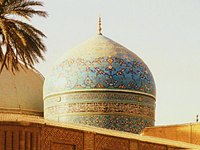
Back الشمس التبريزي Arabic شمس التبريزى ARZ Şəms Təbrizi Azerbaijani شمس تبریزی AZB শামস তাবরিজি Bengali/Bangla Šams-e Tabrizi CEB شەمسی تەورێزی CKB Šams z Tabrízu Czech Schams-e Tabrizi German Şemsi Tebrizi DIQ
Shams-e-Tabrīzī | |
|---|---|
 Bust of Shams in Khoy, Iran | |
| Born | 1185 |
| Died | 1248 (aged 62–63) |
| Resting place | Khoy, Iran |
| Occupation(s) | Weaver, Poet, Philosopher, Teacher, |
| Part of a series on Islam Sufism |
|---|
 |
|
|
Shams-i Tabrīzī (Persian: شمس تبریزی) or Shams al-Din Mohammad (1185–1248) was a Persian[1] Shafi'ite[1] poet,[2] who is credited as the spiritual instructor of Mewlānā Jalāl ad-Dīn Muhammad Balkhi, also known as Rumi and is referenced with great reverence in Rumi's poetic collection, in particular Diwan-i Shams-i Tabrīzī. Tradition holds that Shams taught Rumi in seclusion in Konya for a period of forty days, before fleeing for Damascus. The tomb of Shams-i Tabrīzī was recently nominated to be a UNESCO World Heritage Site.
- ^ a b
- Murtaz̤avī, pizhūhish va nigārish-i Manūchihr (2004). Zabān-i dīrīn-i Āz̲arbāyijān (Chāp-i 2. ed.). Tihrān: Bunyād-i Mawqūfāt-i Duktur Maḥmūd Afshār. p. 49. ISBN 964-6053-61-0.
- Jones-Williams, transl. from the French by J. (1968). Pre-Ottoman Turkey : a general survey of the material and spiritual culture and history c. 1071-1330 (1. publ. ed.). London: Sidgwick & Jackson. p. 258. ISBN 9780283352546.
He may also have met the great Persian mystic Shams al-Din Tabrizi there, but it was only later that the full influence of this latter was to be exerted on him.
- Jenkins, Everett (1998). The diaspora : a comprehensive reference to the spread of Islam in Asia, Africa, Europe, and the Americas, Vol 1. Jefferson, N.C.: McFarland. p. 212. ISBN 978-0-7864-0431-5.
The Persian mystic Shams al-Din Tabrizi arrived in Konya (Asia Minor)
- Arakelova, Victoria; A. Doostzadeh; S. Lornejad (2012). On the modern politicization of the Persian poet Nezami Ganjavi. Yerevan: Caucasian Centre for Iranian Studies. p. 162. ISBN 978-99930-69-74-4.
In a poem from Rumi, the word buri is mentioned from the mouth of Shams Tabrizi by Rumi. Rumi translates the word in standard Persian as biyā (the imperative "come"). This word is also a native word of the Tabrizi Iranian dialect which is mentioned by Persian Sufi, Hafez Karbalaie in his work Rawdat al-Jenān. In the poem of Baba Taher, the word has come down as bura (come) and in the NW Iranian Tati dialects (also called Azari but should not be confused with the Turkish language of the same name) of Azerbaijan, in Harzandi Tati it is biri and in Karingani Tati it is bura (Kiya 1976). Shams Tabrizi was an Iranian Shafi'ite like the bulk of the Iranian population of Azerbaijan during the pre-Mongol and post-Mongol era.
- ^ Ibrahim Gamard, Rumi and Islam: Selections from his stories and poems, Pg Introduction xix